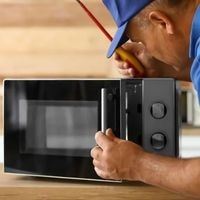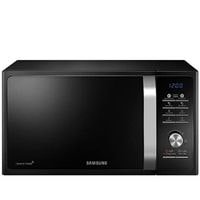Samsung Microwave Not Working. A microwave is an everyday appliance used to heat, cook and defrost food.
This kitchen equipment can be used frequently in the kitchen and because of this, it will show signs of wear and tear or damage sometimes when it is overused by people who are relying on its cooking features daily.
If you have noticed that your microwave has stopped working and there is no power coming from the outlet, first understand what leads to these problems before deciding on a solution that works for you.
Samsung Microwave Not Working
The following is a discussion of some problems with Samsung microwaves that do not work.
Fuse Problem With Ceramics
Microwaves that won’t start or stop working can also be caused by a ceramic fuse. When this part fails, it prevents other parts from fluctuating. It’s located near the power cord in the cabinet and has to be accessed by unplugging it first.
First check a ‘multimeter’ to see if there is continuity with the multimeter, which is a device that checks if electricity is flowing in a wire, if no ‘continuity’ is observed then you’ll know that you must replace this part.
Door Switch Not Working
One of the reasons why the microwave stopped working and will not power on could be due to a faulty door switch. Interlock switches, or door switches, are parts of a microwave that signal the other parts to work when the door is closed and to stop working when the door is opened.
After unplugging the appliance, you’ll need to dismantle the cabinet in order to reach this. With a multimeter, check the continuity of two terminals.
If there’s no continuity then it means that there will be an issue with either one or both of those two terminals and replacement may be needed.
Door Latch Assembly Has A Problem
Another common cause of a microwave that cannot be started could be a problem with the door latch assembly. A lot of microwaves have plastic hooks which extend out of the doorway, signaling other components to start the appliance circuitry when engaged.
If these hooks are not working well or if they’re damaged, the switch will not engage properly and hence the microwave won’t turn on as it should. Inspect this door latch either by removing it from your microwave or simply by peering behind it and determining if you need to replace it with a new one.
Cause With Thermoprotector
Faulty Thermal Fuse Or Cut Out
If you’re experiencing a problem with the microwave, there’s a good chance that it might be related to the thermal fuse. When there’s a lack of continuity on the thermal fuse, this can mean that the protective mechanism in place is preventing the appliance from overheating.
The first step would be to locate and remove the cabinet of your microwave so that you can access the thermostat and disconnect any wiring before checking for power using a multimeter. If no power is detected on either side, then you’ll want to get yourself some new wires that match up to those on your fuse – preferably ones made out of copper or aluminum wire.
Defective Main Control Board
There is a possibility that the main control board may not be working properly. However, this is a rare occurrence. There are a lot of issues when it comes to misdiagnoses, you must test all of the other parts first, to see if there’s something wrong with them, since control boards are often wrongly assessed! The main control board needs to be replaced if you have determined that everything else is working fine.
Faulty Line Fuse
A line fuse in the wall will blow when there is too much current flowing through the microwave circuit. A blown fuse is one of the most common causes of being unable to turn on the microwave when it is shorting out and blowing. Test the continuity of the fuse with a multimeter in order to determine if the fuse has blown.
If the fuse does not show continuity, then it is time to replace it. It is also important to analyze why there was so much current flowing through the circuit that caused the fuse to blow in order to fully resolve the issue for good so as to avoid having to keep replacing the fuses in the future.
Related Guides
